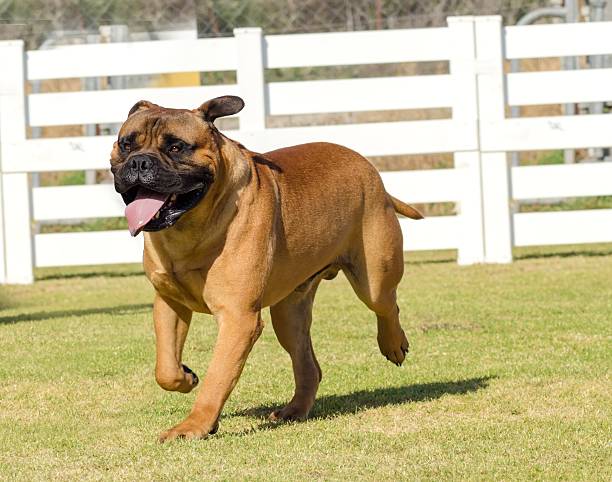Bullmastiff

Breed History:
The Bullmastiff originated in 19th-century England and was developed by crossing Bulldogs with Mastiffs to create a powerful, reliable guard dog. Gamekeepers needed a large, silent, and fearless protector capable of tracking and pinning down poachers without mauling them. The result was the Bullmastiff, often referred to as the "Gamekeeper’s Night Dog."
Recognised for its loyalty and protective instincts, the Bullmastiff quickly gained popularity as a family guardian. Over time, its temperament was refined, shifting from an aggressive enforcer to a calm, affectionate, and trustworthy companion, all while maintaining its natural guarding instincts.
Considering adopting a Bullmastiff or a similar giant breed? Check out our page "How to look after a Great Dane" detailing what to consider before adopting and our recommended products for a Great Dane and other giant dog breeds.
|
Gender |
Height |
Weight |
|
Male |
64–69 cm |
50–59 kg |
|
Female |
61–66 cm |
45–54 kg |
Size – Large
Life Expectancy: 7–9 years

Breed Appearance:
The Bullmastiff is a large, muscular, and imposing breed with a broad chest and solid, compact frame. Its head is square and massive, with a short muzzle, pronounced stop, and dark, expressive eyes. Wrinkles often form across the forehead when the dog is alert, giving it a thoughtful, attentive look.
The coat is short and dense, lying flat against the body. It comes in shades of fawn, red, or brindle, often with a black mask. Despite its size, the Bullmastiff moves with surprising agility and grace, combining strength with fluid movement.
Breed Type – Guard/Companion:
Bred primarily for protection, the Bullmastiff is a natural guardian—loyal, alert, and confident. It is typically calm and gentle with its family but reserved and watchful with strangers. Its protective instincts make it an excellent watchdog, but it is not prone to unnecessary barking or aggression.
While strong-willed and occasionally stubborn, the Bullmastiff is affectionate and devoted to its people. It tends to form strong bonds with family members, including children, and generally does best in homes where it is integrated as a central part of family life.

Training:
The Bullmastiff is intelligent and capable of learning quickly, but its independent nature can pose challenges for inexperienced owners. Training should begin early, with a focus on positive reinforcement, consistency, and calm leadership. Harsh methods may cause fear or resistance and are not recommended.
Obedience training and early socialisation are essential to help the Bullmastiff become a well-behaved, balanced adult. This breed benefits from structured routines and firm boundaries, especially due to its strength and protective instincts.
Health & Care:
Like many large breeds, the Bullmastiff is susceptible to certain health issues, including:
-
Hip and elbow dysplasia
-
Gastric torsion (bloat)
-
Entropion (inward-rolling eyelids)
-
Heart problems
-
Cancer (particularly lymphoma and mast cell tumours)
Due to its heavy frame, joint and bone care are crucial throughout its life. A high-quality diet, controlled feeding, and regular vet checkups are essential for health maintenance. Watch for signs of overheating, as Bullmastiffs can be sensitive to high temperatures.

Living Conditions:
The Bullmastiff is relatively low-energy indoors and adapts well to apartment living if given enough daily exercise. It prefers being close to its human family and can become bored or anxious if left alone for extended periods. A secure yard is ideal but not mandatory if regular walks are provided.
This breed thrives in homes that offer structure, companionship, and consistent engagement. While it doesn't require high levels of activity, daily outings and mental stimulation are important for its overall well-being.
Exercise:
Despite its size, the Bullmastiff doesn’t require extensive exercise. Moderate daily walks and short play sessions are sufficient to keep it fit and mentally engaged. Overexertion, especially in hot weather or during growth stages, should be avoided.
It enjoys sniffing and exploring new environments but typically prefers short bursts of activity over long endurance workouts. Providing interactive toys or simple obedience games can also keep the Bullmastiff mentally sharp.
Grooming:
The Bullmastiff has a low-maintenance coat that requires minimal grooming. Weekly brushing with a rubber mitt or bristle brush helps remove loose hair and maintain coat condition. Shedding is moderate and more noticeable during seasonal changes.
Bathe only as needed, using a mild dog shampoo. Regular ear cleaning, nail trimming, and dental hygiene are essential parts of the grooming routine. Wrinkles around the face and muzzle should be kept clean and dry to prevent irritation or infection.

Advantages:
-
Loyal, protective, and naturally calm around family
-
Quiet and generally non-barking unless necessary
-
Requires relatively low exercise and grooming
-
Adapts to apartment living with proper care
-
Devoted companion and good with respectful children
-
Excellent guard dog with strong protective instincts
Disadvantages:
-
Shorter lifespan compared to many other breeds
-
Prone to several health issues, particularly joint and heart-related
-
Can be stubborn and requires firm, early training
-
May be wary or dominant around unfamiliar dogs
-
Sensitive to heat and can overheat easily
-
Large size may be difficult to manage for some households

